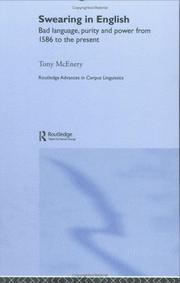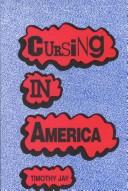| Listing 1 - 7 of 7 |
Sort by
|
Book
ISBN: 9789027256874 9789027265005 902725687X 9027265003 Year: 2017 Publisher: Amsterdam Philadelphia
Abstract | Keywords | Export | Availability | Bookmark
 Loading...
Loading...Choose an application
- Reference Manager
- EndNote
- RefWorks (Direct export to RefWorks)
Any behavior that arouses, as swearing does, controversy, disagreement, disdain, shock, and indignation as often as it imbues passion, sincerity, intimacy, solidarity, and jocularity should be an obvious target of in-depth scholarship. Rigorous, scholarly investigation of the practice of swearing acknowledges its social and cultural significance, and allows us to discover and better understand the historical, psychological, sociological, and linguistic aspects (among others) of swearwords and swearword usage. The present volume brings together a range of themes and issues central to the existing knowledge of swearing and considers these in two key 'new' arenas, that is, in languages other than English, and/or in contexts and media other than spoken interaction. Many of the chapters analysed are based on large and robust collections of data, such as corpora or questionnaire responses, which allow for patterns of swearing to emerge. In other chapters, personally observed instances of swearing comprise the focus, allowing for a close analysis of the relationship between sociolinguistic context and pragmatic function. In each chapter, the cultural aspects of swearing are considered, ultimately affirming the importance of the study of swearing, and further establishing the legitimacy of swearing as a target of research.
Obscene words --- Obscenities (Words) --- Words, Obscene --- Obscenity (Aesthetics) --- Word (Linguistics) --- Slang --- Social aspects --- Research. --- Psychological aspects --- Lexicology. Semantics --- Pragmatics --- Language and culture --- Languages, Modern --- Psycholinguistics. --- Sociolinguistics. --- Swearing
Book
ISBN: 9782600014663 2600014667 Year: 2011 Volume: 473 Publisher: Genève: Droz,
Abstract | Keywords | Export | Availability | Bookmark
 Loading...
Loading...Choose an application
- Reference Manager
- EndNote
- RefWorks (Direct export to RefWorks)
Bien que le XVIe siècle ait la réputation tenace d'être propice aux débauches et truculences, il existe assez peu de travaux d’ampleur consacrés à l’analyse de l’obscénité à la Renaissance en France. Etudier l’obscénité à la Renaissance conduit à observer la formation progressive d’une notion qui fait débat parce que les codes moraux et sociaux dont elle dépend ne sont pas encore établis. Le terme d’« obscène » apparaît dans la langue française à cette époque et l’obscénité prolifère dans des contextes très différents, de la médecine à la musique et de la farce aux récits de voyage – autant de lieux où l’obscénité constitue un défi à l’interprétation, puisqu’elle ne peut se définir qu’à partir de ses effets, et qu’elle brouille les limites entre action et représentation. Ainsi la provocation obscène libère une énergie qui permet de repenser l’édiction de normes morales, d’interroger le fonctionnement des œuvres d’art, d’explorer la nature humaine elle-même.
literature [writings] --- humanism --- History of civilization --- Literature --- anno 1500-1599 --- France --- French literature --- Words, Obscene, in literature. --- French language --- Littérature française --- Mots obscènes dans la littérature --- Littérature --- Français (Langue) --- Terminology. --- Obscene words. --- Terminologie --- Mots obscènes --- Words, Obscene, in literature --- Obscene words --- Littérature de la Renaissance. --- Obscénité --- Obscene words in literature. --- Littérature française --- Mots obscènes dans la littérature --- Littérature --- Français (Langue) --- Mots obscènes --- Literary terms --- Langue d'oïl --- Romance languages --- Thematology --- French literature - 16th century --- French literature - 17th century --- Literature - Terminology --- French language - Obscene words --- literature [documents]
Book
ISBN: 0300017863 9780300017861 Year: 1975 Publisher: New Haven (Conn.): Yale university,
Abstract | Keywords | Export | Availability | Bookmark
 Loading...
Loading...Choose an application
- Reference Manager
- EndNote
- RefWorks (Direct export to RefWorks)
Lexicology. Semantics --- Classical Greek language --- Drama --- Classical Greek literature --- Sociolinguistics --- Sex in literature --- Words, Obscene, in literature --- Sex --- Greek drama (Comedy) --- Greek language --- Scatology in literature --- Terminology --- History and criticism --- Obscene words --- -Greek language --- -Scatology in literature --- -Sex in literature --- Obscene words in literature. --- Gender (Sex) --- Human beings --- Human sexuality --- Sex (Gender) --- Sexual behavior --- Sexual practices --- Sexuality --- Sexology --- Classical languages --- Indo-European languages --- Classical philology --- Greek philology --- Words, Obscene, in literature. --- Scatology in literature. --- Sex in literature. --- History and criticism. --- Obscene words. --- Terminology. --- Sex - Terminology --- Greek drama (Comedy) - History and criticism --- Greek language - Obscene words
Book
ISBN: 9782745328533 2745328530 Year: 2015 Volume: 80 Publisher: Paris: Champion,
Abstract | Keywords | Export | Availability | Bookmark
 Loading...
Loading...Choose an application
- Reference Manager
- EndNote
- RefWorks (Direct export to RefWorks)
Old French literature --- Thematology --- Art --- Drama --- French literature --- Words, Obscene, in literature. --- Obscene gestures --- Littérature française --- Mots obscènes dans la littérature --- Gestes obscènes --- History and criticism. --- History --- Histoire et critique --- Histoire --- France --- Civilization --- Civilisation --- Obscénité --- --Littérature --- --Moyen âge, --- Obscene words in literature. --- Littérature française --- Mots obscènes dans la littérature --- Gestes obscènes --- Littérature --- Moyen âge, 476-1492

ISBN: 9780415544047 0415258375 9780415258371 0415544041 9786610281220 1134514263 1280281227 0203501446 1134514255 9780203501443 Year: 2006 Publisher: London New York Routledge
Abstract | Keywords | Export | Availability | Bookmark
 Loading...
Loading...Choose an application
- Reference Manager
- EndNote
- RefWorks (Direct export to RefWorks)
Do men use bad language more than women? How do social class and the use of bad language interact? Do young speakers use bad language more frequently than older speakers? Using the spoken section of the British National Corpus, Swearing in English explores questions such as these and considers at length the historical origins of modern attitudes to bad language. Drawing on a variety of methodologies including historical research and corpus linguistics, and a range of data such as corpora, dramatic texts, early modern newsbooks and television, Tony McEnery takes a socio-histo
Sociolinguistics --- Historical linguistics --- English language --- Dialectology --- obscene woorden. --- scheldwoorden. --- slang. --- vloeken. --- Corpus linguistics. --- Corpuslinguïstiek. --- Engelse taal --- Swearing --- Power (Social sciences) --- Words, Obscene --- Empowerment (Social sciences) --- Political power --- Exchange theory (Sociology) --- Political science --- Social sciences --- Sociology --- Consensus (Social sciences) --- Profanity --- Cant --- History. --- Social aspects. --- Obscene words. --- Slang. --- Obscene words --- English --- Slang --- English language Slang --- Germanic languages --- English language Obscene words
Book
ISBN: 3878081375 9783878081371 Year: 1981 Volume: 137 Publisher: Tübingen: Narr,
Abstract | Keywords | Export | Availability | Bookmark
 Loading...
Loading...Choose an application
- Reference Manager
- EndNote
- RefWorks (Direct export to RefWorks)
Lexicology. Semantics --- Romance languages --- Slang --- Sublanguage --- Words, Obscene --- Euphemism --- Prostitution --- Bibliography --- -Sublanguage --- -Obscene words --- -Prostitution --- -Female prostitution --- Hustling (Prostitution) --- Prostitution, Female --- Sex trade (Prostitution) --- Sex work (Prostitution) --- Street prostitution --- Trade, Sex (Prostitution) --- White slave traffic --- White slavery --- Work, Sex (Prostitution) --- Sex-oriented businesses --- Brothels --- Pimps --- Procuresses --- Red-light districts --- Sex crimes --- Figures of speech --- Semantics --- Obscenities (Words) --- Obscenity (Aesthetics) --- Word (Linguistics) --- Language for special purposes --- Restricted language --- Special language --- Discourse analysis --- Language and languages --- Register (Linguistics) --- Neo-Latin languages --- Italic languages and dialects --- Argot --- Colloquial language --- Cant --- Obscene words --- Bibliography. --- -Bibliography --- Variation --- -Bibliography. --- -Obscenities (Words) --- Female prostitution --- Slang&delete& --- English language Slang --- English language --- Slang - Bibliography --- Romance languages - Slang - Bibliography --- Sublanguage - Bibliography --- Words, Obscene - Bibliography --- Euphemism - Bibliography --- Prostitution - Bibliography --- Sex work

ISBN: 9027220921 902722093X 155619451X 9786613592613 9027274053 1280497386 9789027220929 9789027220936 Year: 1992 Publisher: Philadelphia : J. Benjamins Pub. Co.,
Abstract | Keywords | Export | Availability | Bookmark
 Loading...
Loading...Choose an application
- Reference Manager
- EndNote
- RefWorks (Direct export to RefWorks)
Who uses dirty words? And when? How is the bad language we use reflected in the movies, in the courts, and elsewhere? With Cursing in America, psychologist Timothy Jay presents the first serious and extensive examination of American profanity from a psycholinguistic-contextual point of view. An amazing amount of factual data gathered through several field studies and numerous laboratory-based experiments reveals the relationship between cursing and language acquisition, anger expression, gender stereotypes and offensiveness. Sexual harassment, censorship, language content of film, obscene phone calls and cursing at public schools are some of the topics which are analyzed and related to the data. Word-by-word tables demonstrate the influence that factors such as frequency of occurrence, degree of offensiveness, and gender and age of the speaker have on obscene language usage in America today
Lexicology. Semantics --- Psycholinguistics --- English language --- Psycholinguistique --- --Langue anglaise --- --Juron --- --Sociolinguistique --- --États-Unis --- --English language --- Blessing and cursing --- Words, Obscene --- Americanisms --- Obscene words --- Psychological aspects --- #SBIB:309H517 --- Verbale communicatie: sociale psychologie van de taal en de interactie, psycholinguistiek --- Americanisms. --- Obscene words. --- Obscenities (Words) --- Obscenity (Aesthetics) --- Word (Linguistics) --- Slang --- Germanic languages --- Cursing and blessing --- Execration --- Imprecation --- Malediction --- Incantations --- Provincialisms --- Dialects --- Américanismes --- Bénédiction et malédiction --- Anglais (Langue) --- Mots obscènes --- Aspect psychologique --- Langue anglaise --- Juron --- Sociolinguistique --- États-Unis
| Listing 1 - 7 of 7 |
Sort by
|

 Search
Search Feedback
Feedback About UniCat
About UniCat  Help
Help News
News